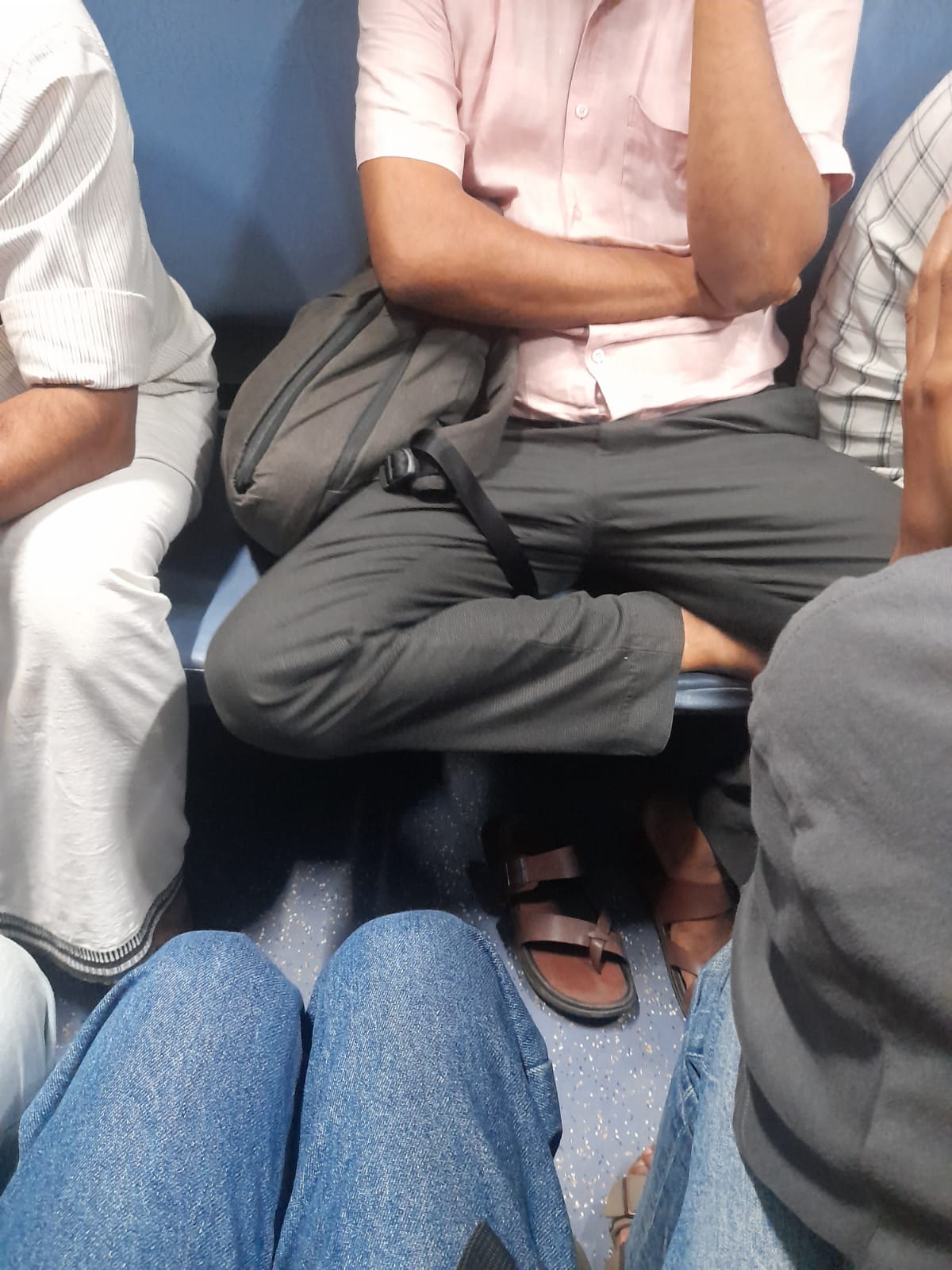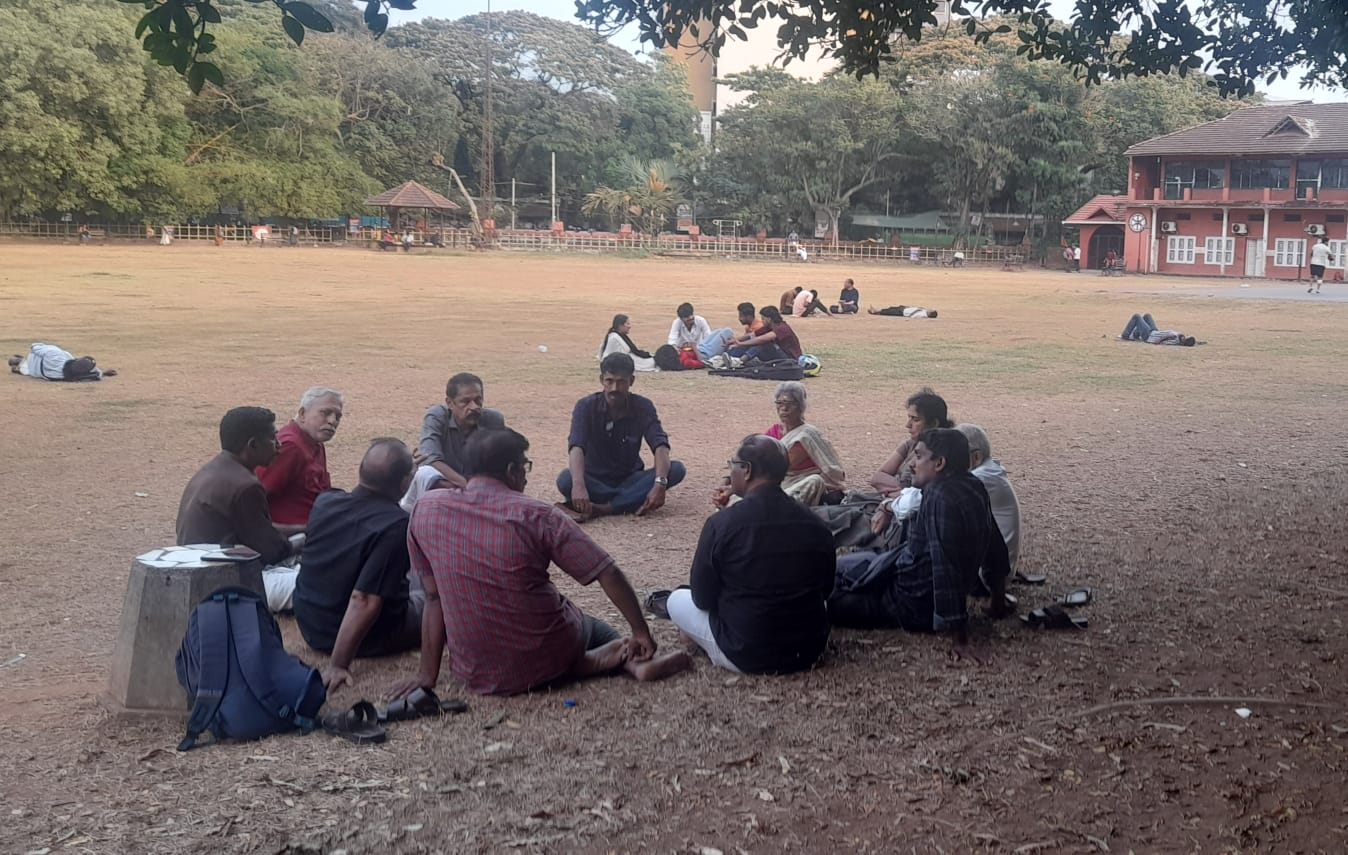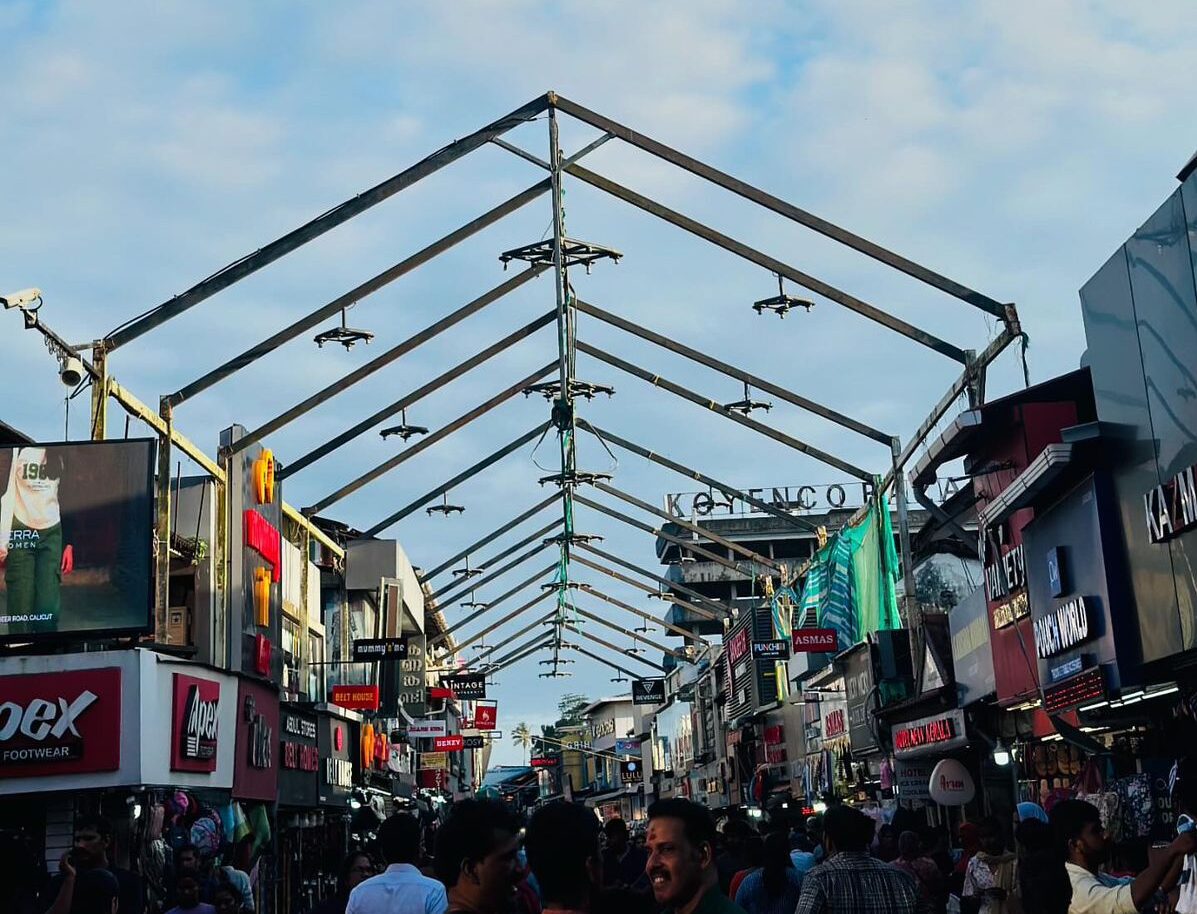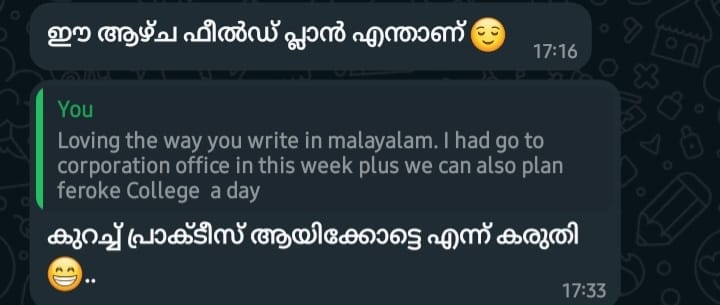Chance brought together Deepti and Anjana, two researchers from different universities and backgrounds conducting fieldwork in Kozhikode. In a two-part reflective piece, they write about how their shadowing each other during fieldwork resulted in friendship, but also the intellectual quest of reading their field sites in a new light.
Read part 1 by Deepti here.
Deepti Sreeram and Anjana S.
Anjana’s notes:
Navigating the Problem
The discipline of social work often imagines the interlocutor as a client. The social worker is expected to work with their client to identify a problem and implement effective interventions after a thorough investigation. With my research, I was mostly doing the same when I was exploring the interaction between the city of Kozhikode and the different gender identities in social spaces. Since my understanding of fieldwork was mostly grounded in staging an intervention around a problem, as social work principles suggest, this pattern of understanding the field has made me look at anything and everything in the field as potential social problems that need to be studied and intervened in. For example, during my interaction with interlocutors, the social work lens would force me to place narratives into categories of social problems such as patriarchal acts, caste discrimination, gender pay gap, etc., and then compel me to imagine possible solutions for them.
Even though doing ethnography involved an immersion in the field, I would often acknowledge the emotions of my interlocutors and stay neutral. One of my biggest fears while getting into the field was whether this problematization approach, where I stayed neutral and looked for solutions, would hinder the free flow of thoughts, eventually affecting the ease of getting immersed in the field. Apart from this, Kozhikode was the district I belonged to, where I placed myself as an ‘outsider’ primarily because of my fewer interactions with the city. Although Vadakara, my hometown, falls in the district of Kozhikode, it is geographically and culturally closer to the district of Kannur. As someone who hailed from such a place that was rural and distant from the city of Kozhikode, I imagined Kozhikode differently. The city always seemed to be a site of jaada (arrogance) and ahambhaavam (ego) for me. Though Kerala displays a rural-urban continuum rather than bounded rural and urban zones, I considered Vadakara to be a slow and peaceful place that was unlike Kozhikode.
It was through the railway that I covered the distance between the two places. The train, while being my conduit, was also my field of observation. Thus, when I would see the morning trains to Kozhikode, I would remember the peak time in Mumbai where one would encounter the Mumbai Kurla-Dadar crowds. I, being regarded as a silent, paavam (innocent/naive) figure, would always find it difficult to cut through the crowds and get onto the train. As I negotiated for a seat or even a space to stand comfortably, I would silently lean on a seat and observe the train from that point. When a seat or a smile was offered, I would use that as an opportunity to interact with the passengers on their travel, work, and opinions about the city dynamics they participated in. Often, I would feel very excited when I got into the ladies’ compartment. As a mark of the spontaneity and generosity offered in response to my frailty, the women around me would often start with ‘pavam kutti, kurach neramayi nikkunnu. Ini irunnolu’ (Poor girl, you have been standing for a while, please sit now).
The ‘pavam’ description often stuck with me even when I was in familiar places. For instance, while talking with one of my neighbors, who is also a research scholar, he would often tell me, “’ngane paavam aayi ninnal onnum ninakk data kittilla. Korach bhakshanam kazhich aarogyam vannitt poykko’ (You won’t get data if you stay this innocent. Eat some food, build up your health, and then go). His remarks, characterising me as ‘innocent’ because of my health/bodily appearance, would often spill into my field encounters.
The Inertia between ‘Pavam’ and ‘Ego’

My initial days of roaming around the city and shuttling between two distant places brought a self-realization that I was not conforming to the ‘pavam’ image that was somehow bound to me. Although men occupying train seats and spreading their legs was widely tolerated, seeing it would make me angry. On most days, I would calmly ask them to shift their legs closer, and they would comply only momentarily, leaving me fuming. Some other days, I would stay silent, chewing on my anger, waiting to reach home and vent to my father. For my father, who was once a regular passenger of such trains, this was a ‘feminazi’ way of thinking that was not conducive. In other words, my refusal to indulge men and their unwelcome stares, along with my resistance to their encroachment of public space was a problem for my father. Even though I disagreed, I was still scared that one of the male passengers would turn out to be a government officer that I would encounter in my field. Given these constant doubts over meeting potential harassers as interlocutors, I began conforming and assimilating into the pavam image as a safer approach in the field. However, this leaning towards being pavam did not prevent me from reacting in spaces or circumstances that weren’t comfortable.
For instance, during a conversation with someone sitting at Mananchira Square, they told me, ‘Pennungal ingane rathri irangi nadakkunnat kondanu rape case okke koodunnat’ (rape cases are rising because of women roaming around freely in the night). Without thinking twice, I reacted to it by saying, ‘That’s how society has conditioned you to think’. He got offended and said, ‘Vijaricha pole athra pavam onnum alla thaan’ (you are not as innocent as I thought).

Some of such incidents drained my energy, predictably so, when I was expected to collect data. At the same time, it added a layer of confusion. What of the pavam image must I retain? How do I navigate the city if I do not know how to stick to this pavam-ness? It was amid such doubts that I met Deepti at the archives of an educational institution. When I unburdened about my sadness and confusion at being unable to interact with people, wasting (I thought) time sitting in public places and observing people, Deepti smiled and replied, that’s how fieldwork is. Unlike me, Deepti loved to read and possessed great conceptual knowledge. Her suggestion to read Michel de Certeau’s ‘Walking in the City’ helped me recognise the significance of balancing fieldwork and reading habits. When she shared her writing strategies, I reflected on how I spent a lot of time thinking about writing up field notes while still being uncertain all the time. And so, when Deepti spoke of a particular concept, connecting it to the books she read, the observations she made, and the films she watched, I realised that there were possibilities in drawing connections between multiple sources. Though I had not heard of the concept of ‘shadowing’ in fieldwork, I immediately agreed when Deepti suggested it to me as a method to do fieldwork together. At the time, I was sure that Deepti’s conceptual knowledge would inspire me to build a praxis-oriented approach in the field.

Our plans of shadowing each other became a reality almost a month after we decided to do it. On the first day, we randomly walked through the city, mapping educational institutions, malls, and hospitals. The conversations ranged from sharing thoughts on field dynamics to our observations on election results, previous research studies and academic anxieties. That day, while we crossed S M street, staff members of some shops began coming over to ask us to buy textile material. Even though I said an immediate no, my no’s were registered as flimsy denials. On the other hand, Deepti’s assertive, ‘njangalkk onnum venda’ (we don’t need anything) was understood loud and clear. As we continued down the street, I kept thinking of how Deepti managed the situation while I had to think of ways to escape the conversation. My thoughts immediately went back to the pavam’ figuration in my mind. Wasn’t this indecisiveness of mine, a form of being pavam? If yes, did the staff think of Deepti’s reaction as ‘enthoru jaadayanu’ (how arrogant)?

While our first day of exploring the city went into a lot of chit-chat about our families, we also spoke about our reading habits in Malayalam. Deepti for example shared her experiences of borrowing books from the Kozhikode public library and how she could not sustain the habit of reading Malayalam books. Although the two of us mostly conversed in Malayalam, to my surprise, Deepti would often text me in Malayalam script—a practice that I had only seen among people over fifty in Kerala—to practice writing in Malayalam. Her enthusiasm towards it also made me install the Malayalam keyboard on my phone and note my field notes in Malayalam, which I would otherwise write in ‘Manglish‘ (a mixture of Malayalam and English).
Rewriting through Shadowing
As we made more plans to meet each other in the field, I was beginning to realise how Deepti’s interest in trying new things was starting to seep into me. For instance, when we attended a focus-group discussion organised by a government authority on a project to reimagine Kozhikode city regarding gender safety and accessibility, the two of us expressed our opinions in the discussion. While my suggestions were diluted by a more soft and fluid form of narrative style, Deepti’s critique was clear and assertive. As the meeting progressed, the two of us could observe how our narrative styles affected the reception towards our observation. To the people in the meeting, my observations were not serious enough because it was couched in tentativeness.
However, on our joint visit to Kozhikode archives, I started recognising how the ‘ego’ and ‘pavam’ portrayals helped us navigate the system better and more efficiently. Since I had not gotten a clearance from the archive, Deepti had taken the lead in securing the archivist’s approval. By engaging the archivist in an eager conversation, and responding with ‘athelle’ (is it so?), Deepti would urge the archivist to share more. Her attempts at trying to earn his confidence helped me secure his approval. However, while talking with a former archives employee at the office, who was well-versed with archival data and minute information on the city, I noticed how my ‘pavam’ portrayal was leading to quicker results. My enthusiasm to listen to stories and queries made him share a lot more past narratives of the city and the people who lived there. When I told him I was in my first year of PhD, he laughed loudly and said, ‘Ninakk samayamund, ni cheriya kuttiyalle’ (you have time; you are still a young girl). Though he did speak to Deepti on the history and trajectory of educational institutions in the city, he always paused and planted his eyes on me to say, ‘Anjana, ninakk ithu upakarappedum. Venamenkil ketta mathi, enikk nirbandhamonnumilla’ (Anjana, this will help you. I am not forcing you, but do listen if you want to). Though he appeared soft while narrating the oral history, I noticed his critical appearance when he shared his reflections on archival data. The experience at the archives showed me how the two of us could take the lead at different points and switch appearances. It also showed me the potential in being pavam. Without necessarily thinking of pavam as passivity or as people-pleasing, I began understanding how a stance should be read through its relation with others.
In the initial days, when Deepti introduced herself as a native of Kozhikode city, my thoughts reflected my conditioned ideas on how the city and its inhabitants wouldn’t fall into the ‘naivete’ that rural areas carry. Even when she appeared to be a young, bold woman with enough experience to identify the city’s pulse, my first few conversations with her and her experiences of navigating the city redefined my lens of looking at the city through the static frames of ‘ahambhaavam’ (ego) and ‘jaada’ (arrogance). I was fascinated with how we both understood the portrayal of our characters and appearances as this dance between emotional states. Our collaboration showed us that we could shuttle between an array of appearances while creating a supportive soil for our collaboration. Even though we began with a static imagination of what ego or pavam was, we could move away from such judgments and radically rewrite the relationship between the self and the field.
About The Author: Anjana is a second-year doctoral student at the Tata Institute of Social Science, Mumbai. She looks at the interaction between the city and different gender identities through the medium of social spaces in her research. She is a native of Kozhikode, Kerala.

I found your ‘ paavam’ self an interesting way to get people to talk to you. Kozhikode was my hometown many decades ago. Thus, I found your walking through SM Street etc very nostalgic. Participant observation is a good way to get others to speak.
Hi, I love this piece, I would really love to speak more about your fieldwork experience and potentially collaborate in the field, I also collect oral histories. Please email me if possible, mallory.cerkleski@sns.it.